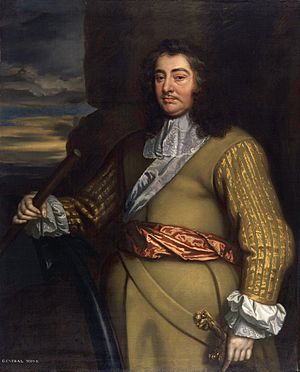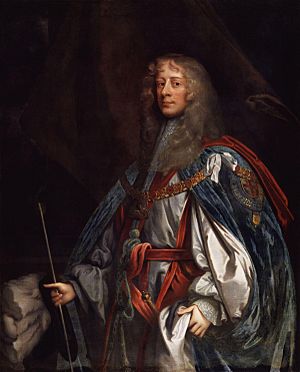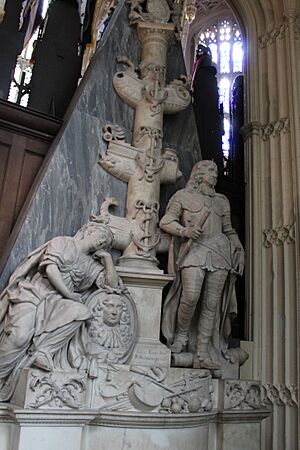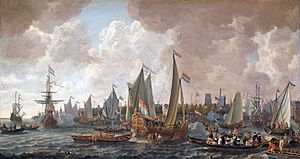George Monck, 1st Duke of Albemarle facts for kids
Quick facts for kids
The Duke of Albemarle
|
|
|---|---|

Portrait by Peter Lely
|
|
| Chief Minister of Great Britain Lord High Treasurer |
|
| In office June 1667 – January 1670 † |
|
| Lord Lieutenant of Middlesex | |
| In office 1662 – 1670 † |
|
| Custos Rotulorum & Lord Lieutenant of Devon | |
| In office July 1660 – January 1670 † |
|
| Lord Deputy of Ireland | |
| In office June 1660 – February 1662 |
|
| Member of Parliament for Devon |
|
| In office April 1660 – July 1660 |
|
| Commander-in-Chief Scotland | |
| In office April 1654 – February 1660 |
|
| General at sea | |
| In office 1652–1653 |
|
| Personal details | |
| Born | 6 December 1608 Potheridge, Devon |
| Died | 3 January 1670 (aged 61) Potheridge, Devon |
| Resting place | Westminster Abbey |
| Nationality | English |
| Spouse | Anne Clarges (1653–his death) |
| Children | Christopher Monck, 2nd Duke of Albemarle |
| Occupation | Professional soldier and naval officer |
| Military service | |
| Rank | Captain General |
| Battles/wars | Anglo-Spanish War (1625–1630) Cádiz expedition (1625) Anglo-French War (1627–1629) St Martin-de-Ré Eighty Years' War Maastricht; Breda Wars of the Three Kingdoms Newburn; New Ross; Nantwich; Dunbar; Dundee; First Anglo-Dutch War Portland; The Gabbard; Scheveningen; Glencairn's rising Second Anglo-Dutch War Four Days' Battle; St. James's Day Battle |
George Monck, 1st Duke of Albemarle (born 6 December 1608 – died 3 January 1670) was an English soldier. He played a very important role in English history. He fought on both sides during the Wars of the Three Kingdoms, a series of civil wars.
Monck was a key military leader during the time England was a republic, called the Commonwealth. His support was vital in bringing back King Charles II to the throne in 1660. For this, Charles II gave him the title Duke of Albemarle and many other important jobs.
Monck started his military career in 1625. He served in the Eighty Years' War until 1638. He then went to Ireland to help stop a rebellion. He became known for being very effective. He was captured in 1644 while fighting for the Royalists. He was a prisoner for two years.
After his release in 1647, he became a commander for Parliament. He fought in Scotland and at sea. From 1655 to 1660, he led the army in Scotland. His support for bringing back the monarchy was a major reason Charles II became king again in May 1660.
After 1660, Monck was less involved in politics due to illness. However, he returned to sea during the Second Anglo-Dutch War. He also played a big part during the Great Plague of London in 1665 and the Great Fire of London in 1666. He spent his last years in retirement and died in January 1670.
Contents
George Monck's Early Life
George Monck was born on 6 December 1608. His family home was Potheridge in Devon, England. He was the second son of Sir Thomas Monck and Elizabeth Smith. His mother's father, Sir George Smith, was a very rich man.
The Monck family was one of the oldest in Devon. However, they were not very wealthy. Sir Thomas Monck faced financial problems. In 1625, he was put in prison because of debt. He died there two years later.
In 1653, George Monck married Anne Clarges. She was the daughter of a London farrier (someone who shoes horses). Her brother, Thomas Clarges, was a loyal supporter of the king. He later became a knight. George and Anne had one son, Christopher Monck, 2nd Duke of Albemarle.
Starting a Military Career
Monck chose to become a professional soldier. This was a common path for younger sons from less wealthy noble families. His first military experience was in November 1625. He took part in a failed attack on Cádiz, Spain. He was an ensign, a junior officer.
He also joined another difficult expedition in July 1627. This was against St Martin-de-Ré. He spent most of the next ten years serving in the Dutch States Army. This army was known as the best place to learn about war. Many future English Civil War officers trained there.
Monck served under famous commanders. By 1637, he was a lieutenant colonel. He helped storm Breda, a major Dutch victory. After a disagreement, he left the Dutch army in 1638. He returned to England.
He fought in the Bishops' Wars in 1639 and 1640. These were conflicts between England and Scotland. Monck was one of the few who performed well at the Battle of Newburn in 1640. He saved the English artillery from being captured.
Fighting in Ireland and England

In 1641, a rebellion broke out in Ireland. The English Parliament sent an army to stop it. Monck became a colonel in one of these regiments. He arrived in Dublin in January 1642. He served under the Earl of Ormond.
Monck fought against rebel strongholds in Leinster. He gained a reputation for being tough. However, the First English Civil War began in England in 1642. This meant Ormond's army in Ireland could not get more help. By mid-1643, the Catholic Confederacy controlled most of Ireland.
Ormond made a truce with the Confederacy in September 1643. Monck and many other officers did not want to join the king's side. But Monck eventually agreed to support the Royalists. He was captured at Nantwich in January 1644. He was held prisoner for two years.
After his release in 1647, Parliament appointed him commander. He led forces in Eastern Ulster, Ireland.
Monck During the Republic

Monck proved his loyalty to Parliament. He refused to join the Second English Civil War. He made his officers declare their support for Parliament. However, his position in Ulster became difficult. This was after King Charles I was executed in January 1649.
Ulster had many Scottish Presbyterian settlers. They were against the king's execution. Monck made a secret truce with a Catholic leader in Ulster. He did not tell Parliament right away. When he was called to London, Parliament understood his difficult situation.
Oliver Cromwell trusted Monck. He gave him command of a regiment in the Anglo-Scottish War (1650-1651). Monck fought at the Battle of Dunbar. He also helped capture Dundee.
Monck remained loyal to Cromwell. Cromwell made him military commander in Scotland. In 1652, Monck became very ill. He retired to Bath to recover. When the First Anglo-Dutch War began, Monck became a General at Sea. He fought in important naval battles in 1653. These included Portland and Scheveningen.
In 1654, Monck was sent back to Scotland. He put down a Royalist uprising. He was very effective and by 1655, Scotland was peaceful. He stayed in this role for five years. He made sure his officers were loyal to Cromwell's government.
Bringing Back the King
When Oliver Cromwell died in September 1658, his son Richard became Lord Protector. Monck supported Richard. However, the army leaders soon removed Richard Cromwell from power. England seemed to be falling into chaos. Many people wanted new elections and an end to military rule.
Monck declared his support for Parliament. He marched his army towards England. He was joined by Sir Thomas Fairfax, another former army commander. The opposing army, led by John Lambert, fell apart. On 2 February, Monck entered London. In April, new elections were held for a Convention Parliament.
Monck's support was essential for bringing back the monarchy. However, historians believe he was following what most people wanted. Most English people now wanted the king to return.
King Charles II issued the Declaration of Breda on 4 April 1660. This declaration was largely based on Monck's ideas. It promised a general pardon for actions during the civil wars. It also promised religious tolerance. Parliament then invited Charles to return to England. He arrived in London on 29 May.
Later Years and Death
In July 1660, Monck was made Duke of Albemarle. He also joined the Privy Council. He received valuable lands and a pension. He also helped his family and friends get important jobs.
Monck became ill again in August 1661. He avoided front-line politics after this. He focused on increasing his personal wealth. His wife was known for selling official positions. This was a common practice at the time.
In 1663, Monck was given land in the Province of Carolina. This area is now South and North Carolina in the USA. Albemarle Sound is named after him. He also became a shareholder in the Royal African Company. This company was involved in the Atlantic slave trade. This trade caused tension between England and the Netherlands.

The Second Anglo-Dutch War began in 1665. Monck supported this war. He took on administrative duties at the Admiralty. He became very popular for staying in London during the Great Plague of London in 1665. Most of the government had left the city.
Monck shared command of the fleet in 1666. The Four Days' Battle in June was a Dutch victory. But the English won the St. James's Day Battle in July. In September, he was called back to London. He helped restore order after the Great Fire of London.
This was his last active command. The English fleet faced money problems. This led to the embarrassing raid on the Medway by the Dutch in June 1667. Monck was one of the few who was not blamed by Parliament. He was appointed First Lord of the Treasury.
However, Monck was suffering from severe edema (swelling). This made it hard for him to attend meetings. He died on 3 January 1670. His wife died three weeks later. He was buried in Westminster Abbey. A monument was later built there in his honor.

See also
 In Spanish: George Monck para niños
In Spanish: George Monck para niños



